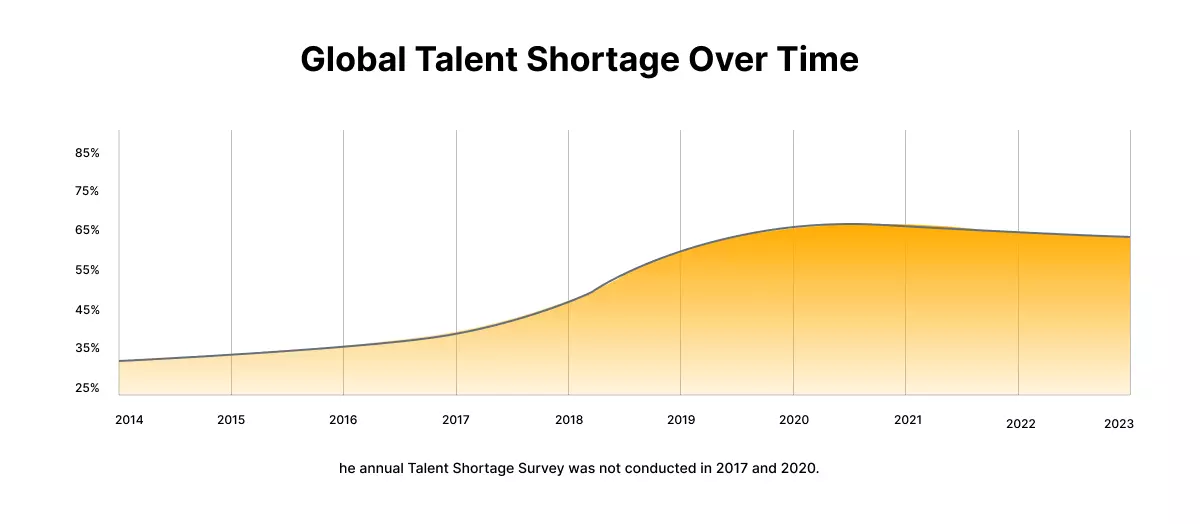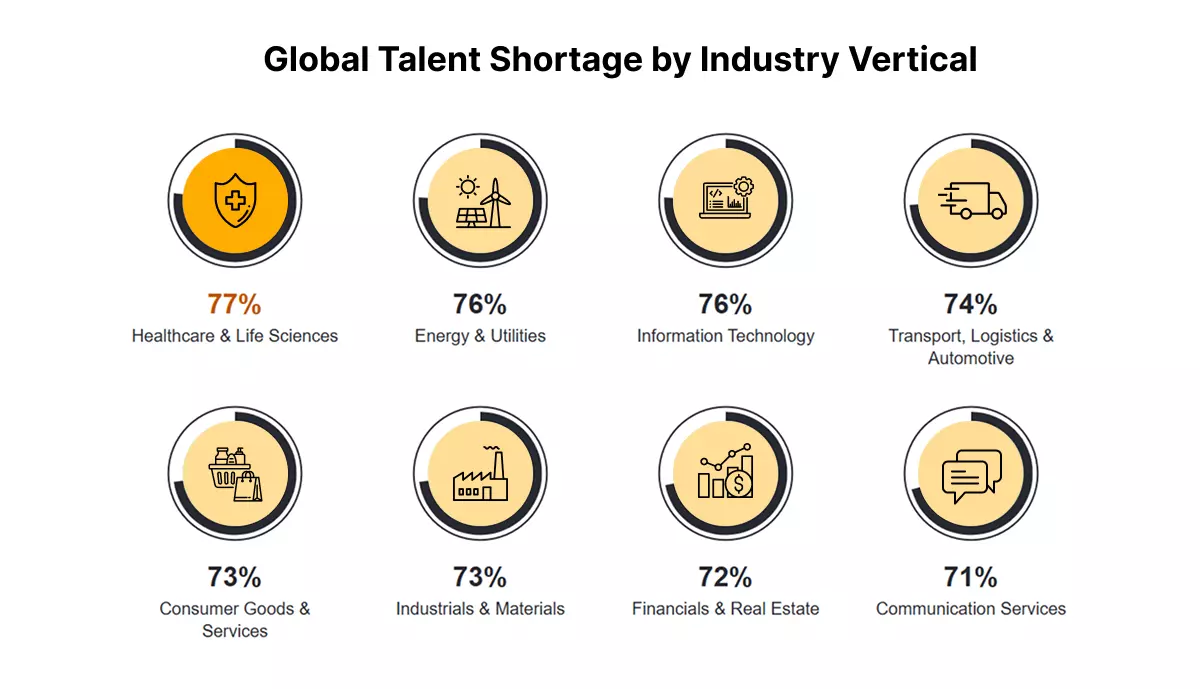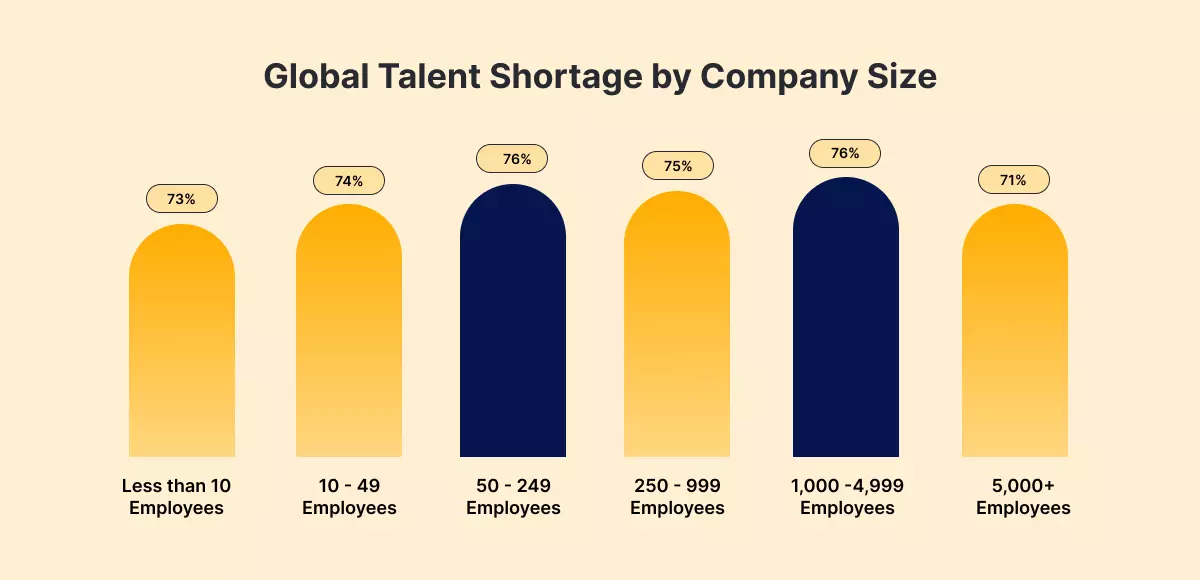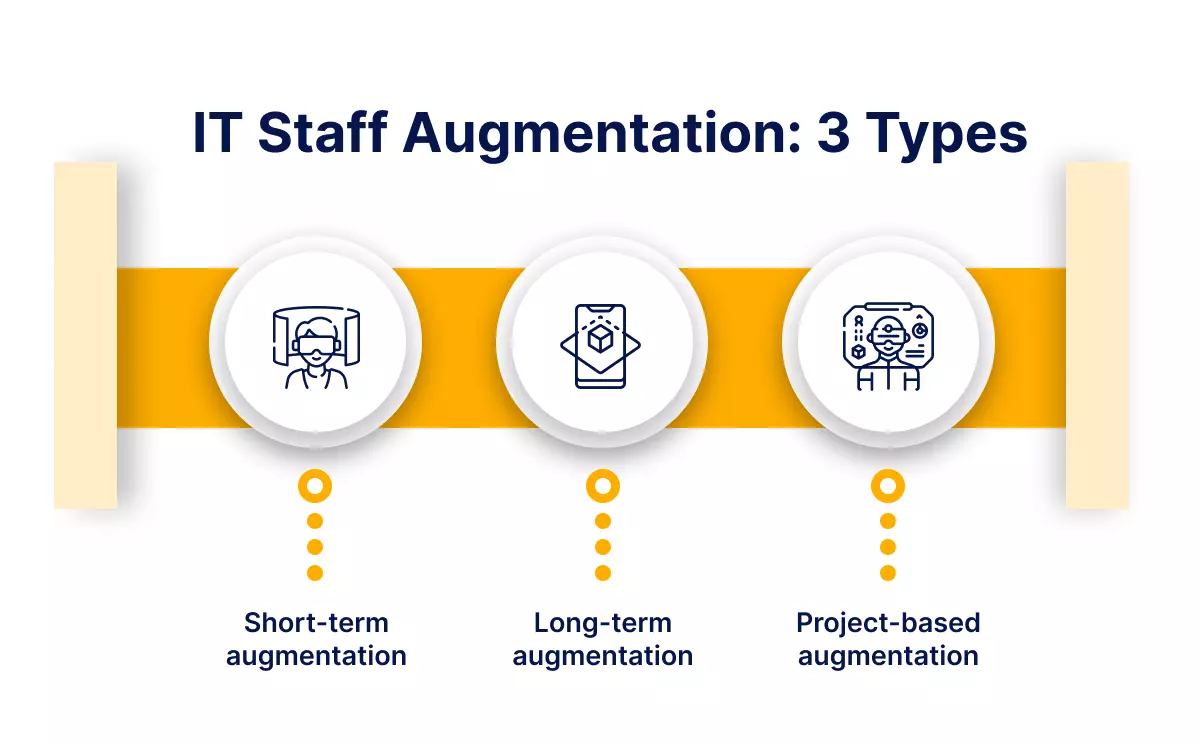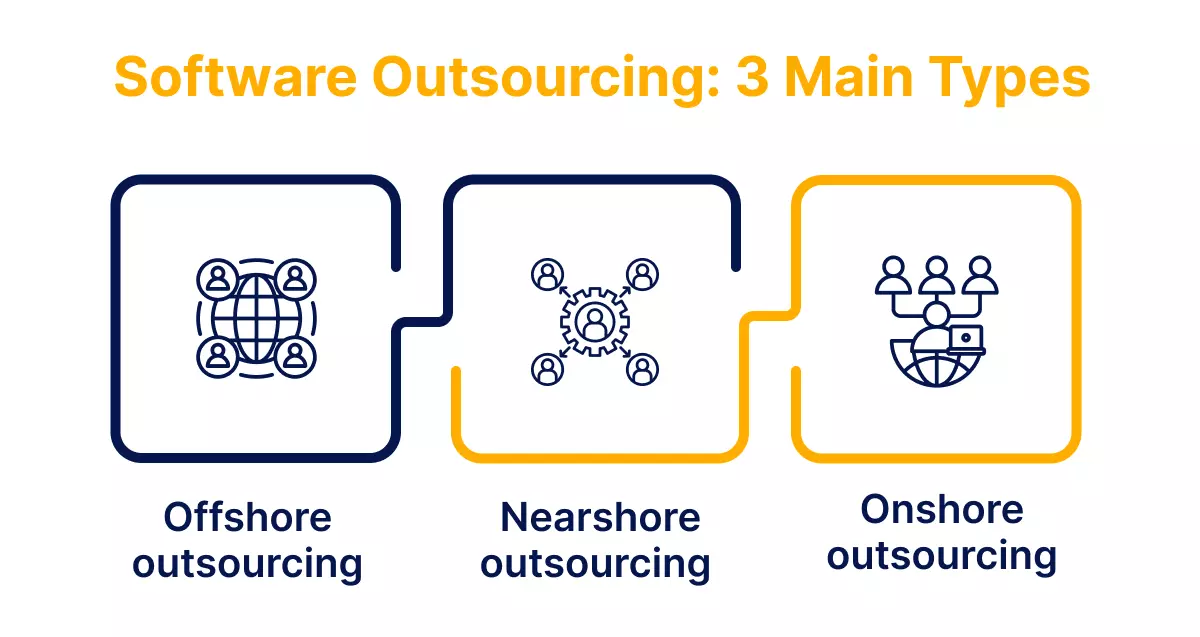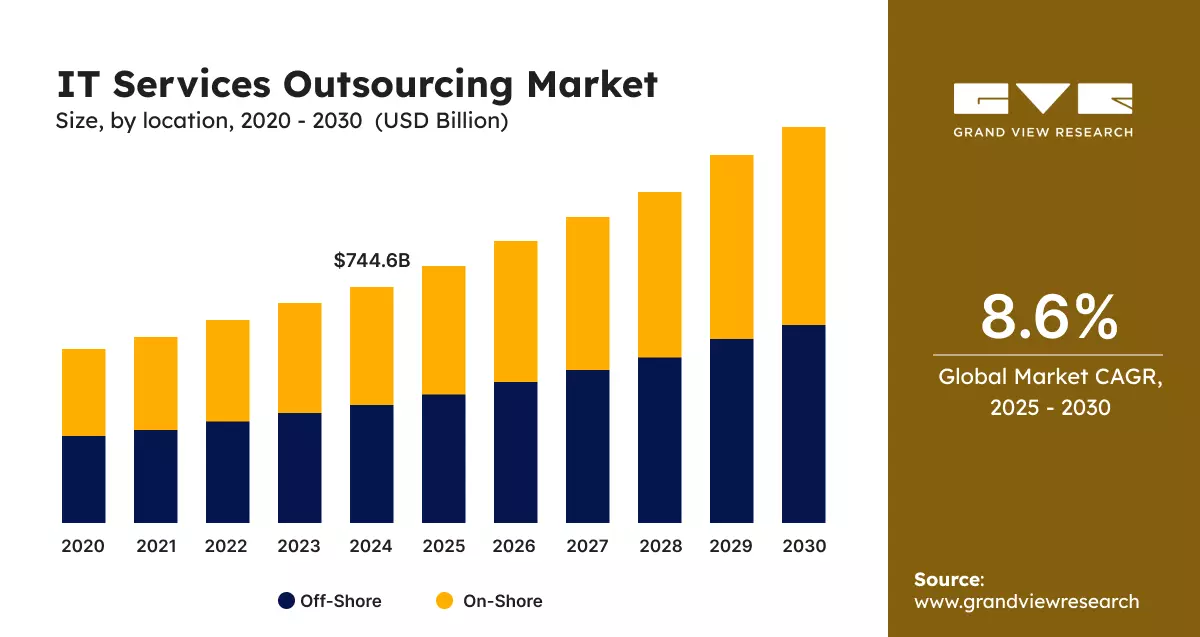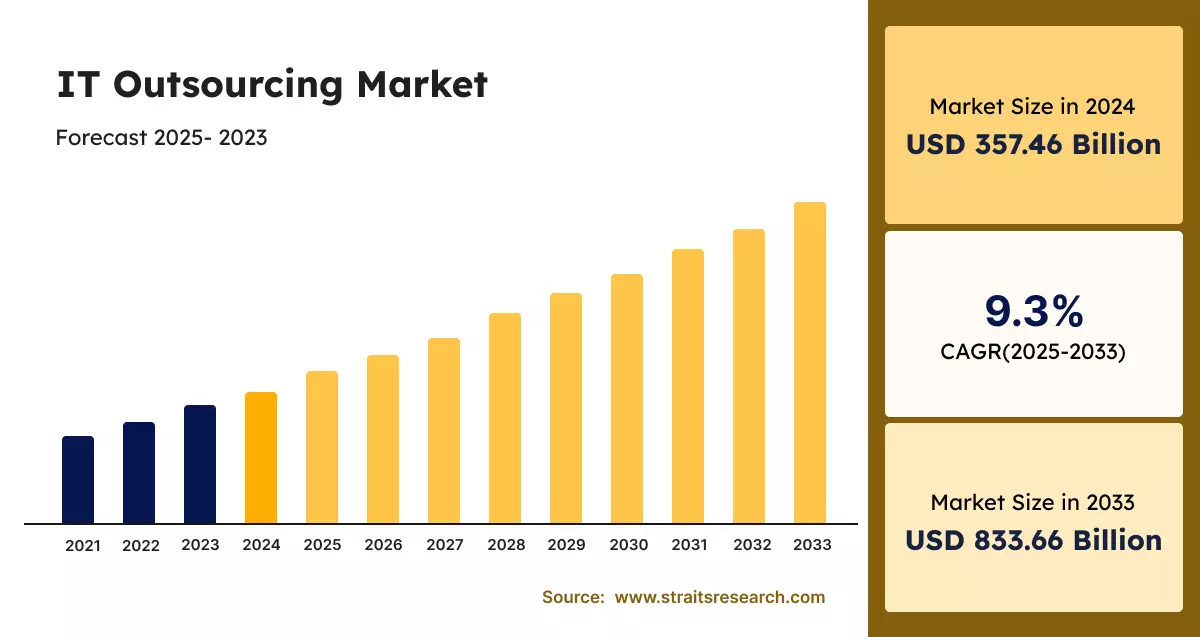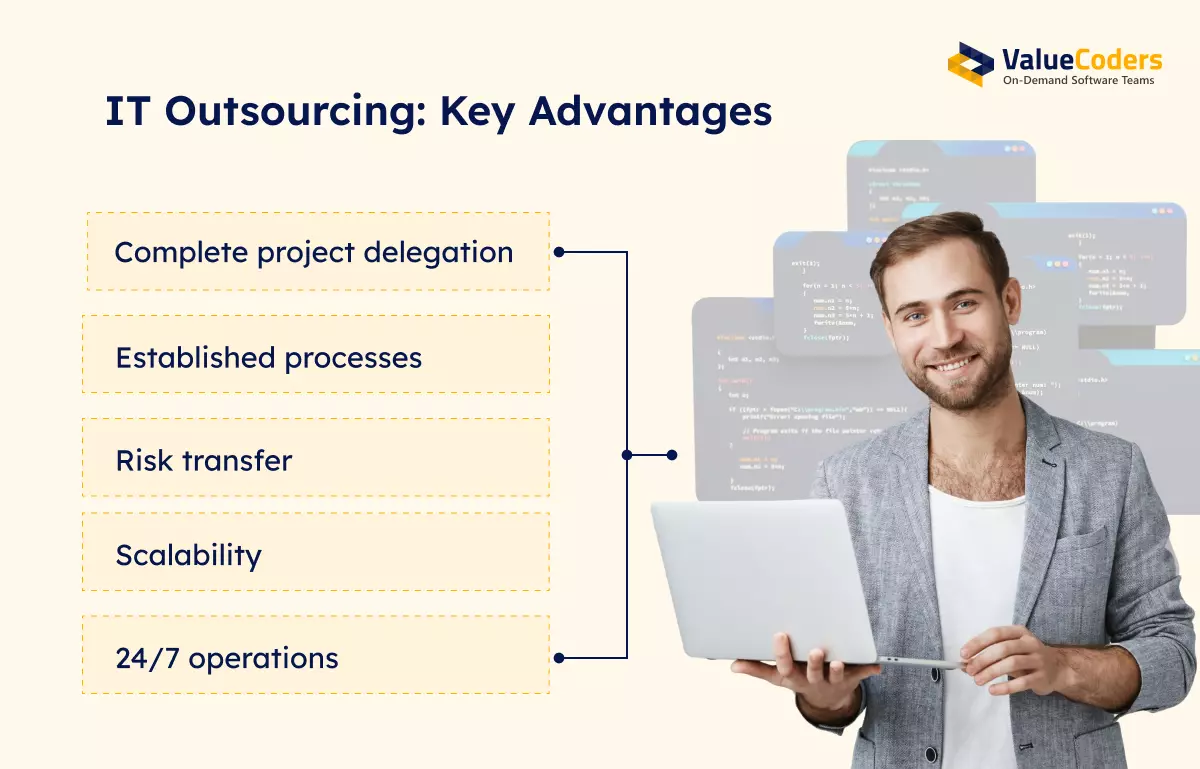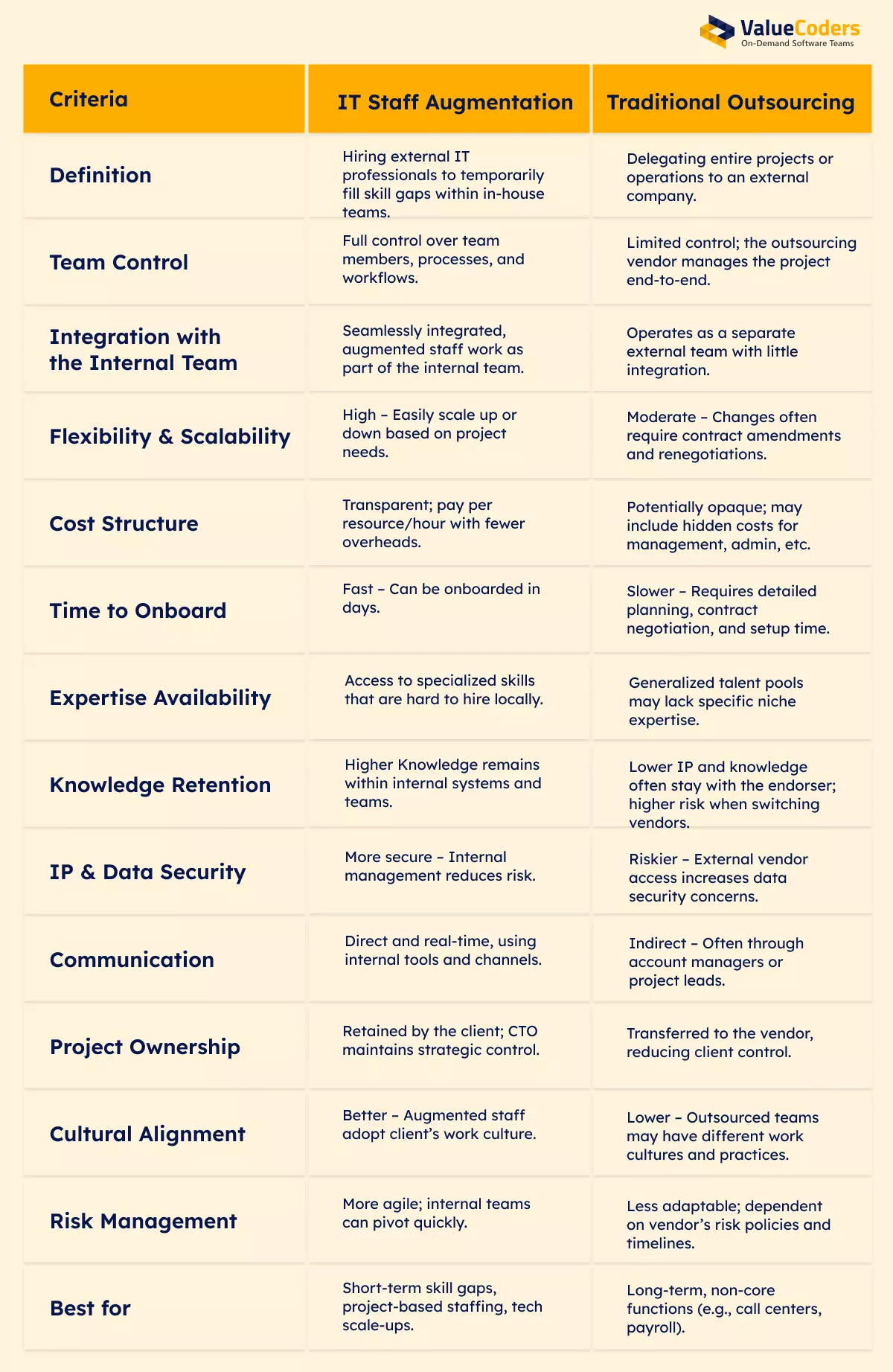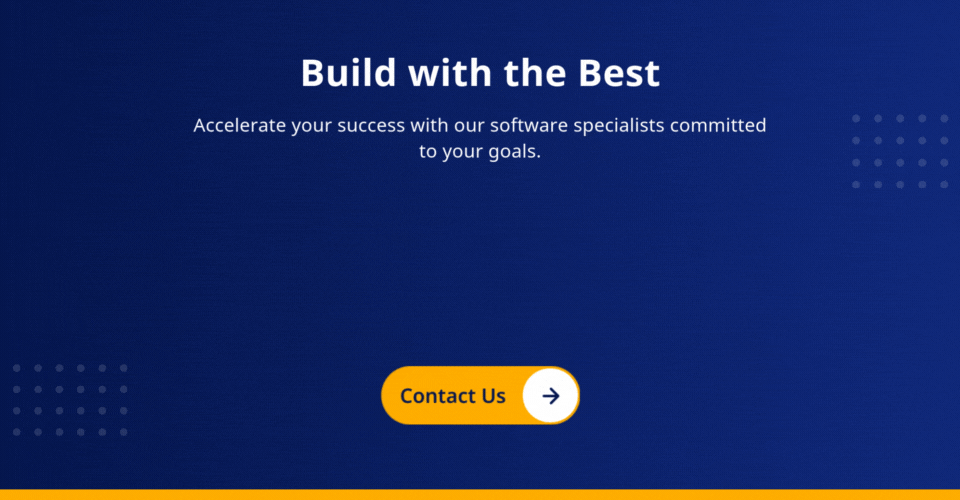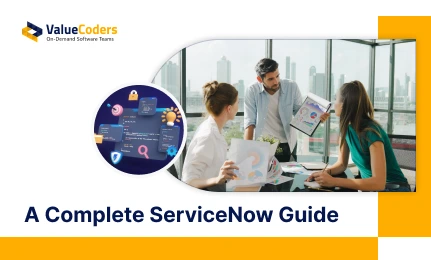Want to deliver product features faster, but struggling with talent gaps?
Opting for full-time hiring or outsourcing may be time-consuming, expensive, and short-term goal-misaligned. That is where the staff augmentation model performs better, as it provides scalable, flexible, and efficient solutions in relatively less time.
According to Verifiedmarketresearch, the IT staff augmentation service market is going to reach a value of USD 857.2 billion by 2031 at an expected CAGR of 13.2% during 2024-2031.
Let’s read further to explore the key differences between “IT staff augmentation vs Traditional outsourcing” and know the top reason why CTOs of SaaS companies choose augmented teams to scale their engineering velocity.
What Reports Say About Talent Gaps?
The three different scenarios of “talent shortage” have been demonstrated here:
- As per a recent report by manpowergroup, 74% of employers do not have access to the appropriate talent to fill the skills gap.
- According to Gartner’s future of work insights 2025, most CTOs currently feel there are not enough skilled people around. This is why IT staff augmentation is becoming a go-to solution, as it helps them hire quickly without waiting for months.
- According to McKinsey’s tech trends outlook, generative AI has become a center of innovation. And, it requires talented AI experts, which is difficult to find for many companies, as CTOs have analyzed. However, IT staff augmentation services can ease this job.
An Overview of IT Staff Augmentation
In a world where project timelines shrink along with increasing demand for niche experts, IT staff augmentation helps bridge the gap by providing businesses access to tech experts on demand.
Rather than outsourcing entire project, the IT staff augmentation process involves hiring skilled developers, QA testers, designers, engineers, etc., from an external vendor to work on your project temporarily.
The IT staff augmentation model is an ideal solution for:
- Filling skill gaps
- Bringing specialized talent
- Scaling teams during high-demand
Staff augmentation comes in three main types:
- Short-term augmentation includes critical projects or short-term spikes in workload. Companies engage experts for definite deliverables, and the agreement period usually varies from 3-12 months.
- Long-term augmentation fills constant gaps in skills. Companies contract professionals for longer durations. Such engagements may last from 1-3 years or longer.
- Project-based augmentation focuses on specific initiatives. Teams form around particular goals, and the members disperse once objectives are met.
Before we proceed further, let’s have a good understanding of its market scenario:
- The IT staff augmentation model is beneficial for companies seeking top tech talent and willing to hire them within a shorter timeframe.
- According to SIA survey, a good portion of businesses use IT staff on assignments that usually last between 18 and 23 months, indicating there is a significant demand for skilled workers over time.
- Since staff augmentation is much affordable for CTOs than hiring full-time staff locally, SpendEdge predicts that companies globally will spend approximately USD $81.87 billion on staff augmentation by 2025.
Avoid fixed costs and get on-demand access to 675+ engineers trusted by 97% of our long-term enterprise partners.
Key Benefits of the IT Staff Augmentation
This approach differs from traditional outsourcing. The benefits of staff augmentation are as follows:
1. Cost Efficiency
Staff augmentation also lowers operational costs by not paying full-time employment rates, including benefits, office space, and equipment. They only pay for productive work hours.
- Augmented staff work remotely or use existing office space
- They bring their own equipment and tools
- Salary differences create additional savings
- Quality remains high while costs drop
2. Access to Global Talent
Geographic boundaries disappear with staff augmentation. Companies can hire the best professionals regardless of location. This global reach solves local talent shortages immediately.
- Video calls, collaboration tools, and PM platforms connect teams across continents
- Time zone differences become manageable with proper planning
- Different perspectives improve problem-solving
- International experience enhances product development
- Global teams understand diverse market needs better
3. Specialized Skills
Every project requires specific expertise. Staff augmentation provides access to niche specialists who bring deep knowledge in emerging technologies.
Specialists come with proven track records. Their experience prevents common mistakes and accelerates development timelines. Examples of specialized skills include:
- AI and machine learning implementation
- Blockchain development and smart contracts
- Cloud architecture and DevOps practices
- Cybersecurity and compliance frameworks
- Mobile app development for specific platforms
Get free consultation and let us know your project idea to turn it into an amazing digital product.
4. Low Risk
Staff augmentation minimizes various business risks. Technical risks decrease too, as the specialists bring expertise that prevents costly mistakes.
- Poor performers can be replaced quickly without complex HR processes
- Contract flexibility protects against market changes
- Allows rapid team scaling without layoffs or severance packages.
- Identify potential issues early
- Guides teams away from common pitfalls
5. Minimal Paperwork
Traditional hiring involves extensive documentation that consumes significant time and resources. Staff augmentation simplifies this process.
- Service providers handle most administrative tasks
- Focus on project requirements rather than paperwork
- Legal complications have reduced dramatically
- Employment law compliance becomes the provider’s responsibility
- Visa requirements, tax obligations, and labor regulations are handled externally
Also Read: Top 23 IT Staff Augmentation Service Companies in 2025
6. Quick Hiring Process
Speed matters in competitive markets. Traditional recruitment takes 2-6 months for technical roles. But, staff augmentation reduces this timeline to 1-4 weeks. The process moves faster because:
- Pre-vetted candidates are available immediately
- Interview rounds focus on technical fit
- Contract negotiations are streamlined
- Onboarding processes are standardized
- Product launches stay on schedule
- Revenue generation starts sooner
7. Full Control
CTOs maintain complete authority over augmented team members. They assign tasks, set priorities, and monitor progress directly. This control ensures alignment with company objectives.
- Communication flows naturally within unified teams
- No intermediary vendors create bottlenecks
- Performance management stays internal
- Companies can address issues directly with team members
- Feedback loops remain short
- Quality standards are enforced consistently
We onboard top 1% tech talent in under 72 hours; used by Fortune 500s and funded startups alike.
An Overview of Traditional Outsourcing
Traditional outsourcing transfers entire projects or functions to external vendors. Companies hand over responsibility for specific deliverables.
This model involves complete delegation:
- Vendors handle project planning
- External teams execute all development work
- Client companies receive finished products
- Communication happens through account managers
Three main outsourcing models exist:
- Offshore outsourcing moves projects to distant countries. Cost savings are maximum but communication challenges increase. Time zone differences complicate collaboration.
- Nearshore outsourcing utilizes neighbouring nations. Similar cultures and time zone congruity enhance coordination. Costs are still lower than in domestic alternatives.
- Onshore outsourcing maintains projects within the same nation. Communication is easiest but cost savings are minimal. This model addresses specific skill shortages rather than cost optimization.
When it comes to its market scenario, the IT outsourcing market witnesses an impressive growth worldwide.
As per analysis by Statista, the IT outsourcing industry will grow to US$806.55 billion by 2030 with a CAGR of 6.51% from 2025-2030.
According to Grandviewresearch report, the IT outsourcing services market is anticipated to reach USD 1219.31 billion by 2030 with a CAGR of 8.6% from 2025-2030.
Another analysis by straitsresearch, the size of the global IT outsourcing market value is forecast to increase to USD 833.66 billion by 2033 at a CAGR of 9.3% during 2025-2033.
Key Benefits of IT Outsourcing
Traditional outsourcing offers several advantages that make it suitable for specific scenarios:
- Complete project delegation removes management burden from internal teams. Companies can focus on core business activities while vendors handle technical execution.
- Established processes come with experienced vendors. They have refined methodologies for common projects. Quality standards and delivery timelines are predictable.
- Risk transfer shifts responsibility to external parties. Vendors guarantee deliverables and timelines. Performance penalties protect client interests.
- Scalability allows rapid capacity expansion. Large outsourcing firms can assign dozens of developers to urgent projects. Resource allocation happens quickly.
- 24/7 operations become possible with global vendors. While domestic teams sleep, international partners continue working. Development cycles accelerate significantly.
Also Read: Staff Augmentation Vs. Project Outsourcing Vs. Managed Services
Staff Augmentation vs Traditional Outsourcing: Key Comparison
Both approaches have their place in the IT landscape. However, more CTOs are choosing staff augmentation over traditional software development outsourcing services.
Why?
Let’s look at the following key comparison of “IT staff augmentation vs outsourcing”:
Top Reasons Why CTOs Prefer Staff Augmentation
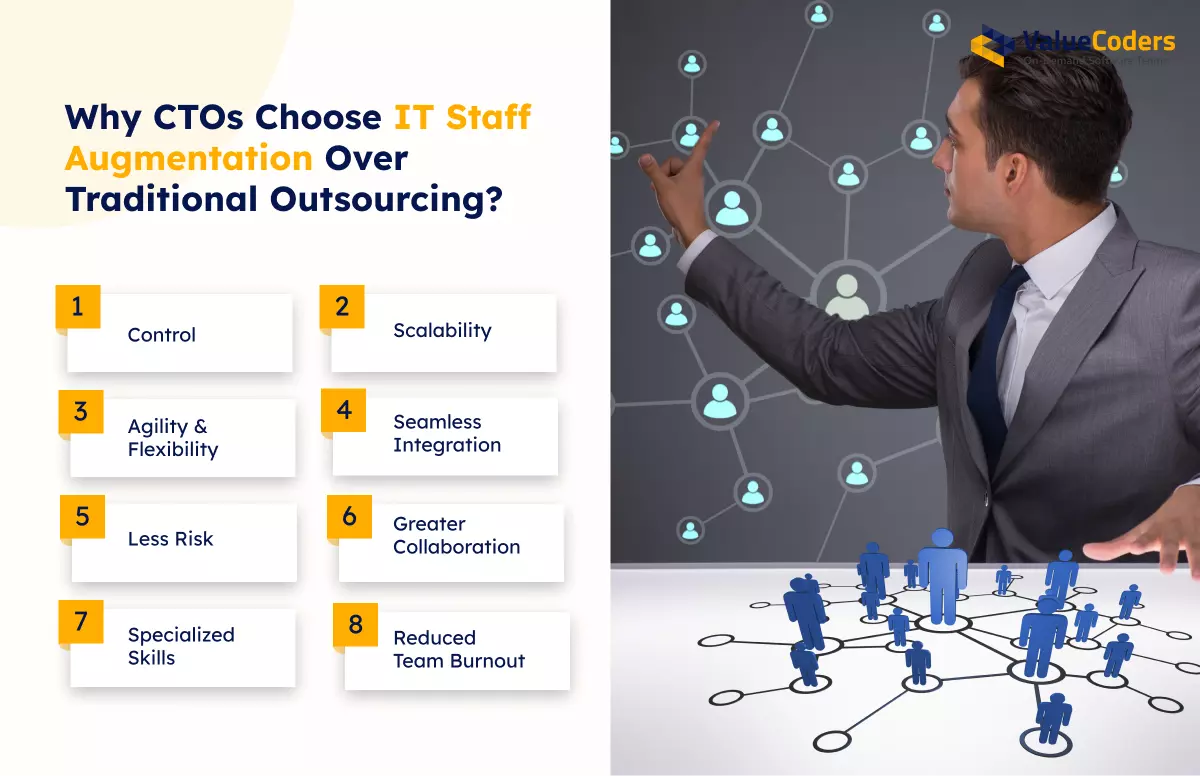
1. Control
CTOs need direct authority over their technology teams. Staff augmentation preserves this control while traditional outsourcing transfers it to external vendors.
- Staff augmentation maintains reporting structures
- Augmented professionals report directly to internal managers
- Performance feedback happens immediately
- Course corrections are implemented without delay
Also Read: How Is IT Staff Augmentation A Unique Talent Option For The Startups?
2. Scalability
Technology projects have unpredictable resource requirements. Staff augmentation provides the scalability CTOs need to handle changing demands effectively.
- Market opportunities require immediate responses
- Competitor actions demand quick countermeasures
- Staff augmentation provides the agility
3. Agility & Flexibility
Software development requirements change constantly. CTOs need flexible approaches that adapt to new conditions quickly.
- Staff augmentation provides exactly the right expertise
- Technology stacks evolve rapidly
- New frameworks emerge monthly
Access full-time developers without the overhead; boost team agility and control with our proven IT staff augmentation model.
4. Seamless Integration
Internal teams work most productively when everyone follows the same processes and culture. Staff augmentation creates unified teams while outsourcing maintains separation.
- Integration affects knowledge transfer
- Augmented team members learn the company systems
- They maintain and enhance code long-term
- Documentation happens naturally through collaboration
5. Less Risk
CTOs must minimize project risks while maintaining delivery schedules. Staff augmentation reduces various risk categories that traditional outsourcing amplifies.
- Performance risks decrease with direct management
- Cultural misalignment becomes obvious quickly
- Technical debt accumulation gets controlled immediately
- Vendor dependency risks disappear
6. Greater Collaboration
Software development succeeds through close collaboration. Staff augmentation promotes natural teamwork while outsourcing creates artificial barriers.
- Collaboration extends to knowledge sharing
- Augmented professionals teach new technologies to internal staff
- Internal team members share domain expertise
- Mutual learning accelerates project success
- No vendor boundaries slow communication
7. Specialized Skills
Technology projects often require niche expertise that internal teams lack. Staff augmentation provides immediate access to specialists while outsourcing adds vendor overhead.
- Staff augmentation provides access to experts without permanent salary commitments
- Projects get the right expertise at the right time
- Staff augmentation connects companies with leading practitioners
8. Reduced Team Burnout
Internal teams often face overwhelming workloads during critical projects. Staff augmentation provides relief while maintaining project quality and timelines.
- Augmented team members energize existing staff
- Work-life balance improves when teams have adequate resources
- Project quality increases when pressure decreases
- Long-term productivity benefits offset short-term augmentation costs
Work with pre-vetted engineers from a pool of 650+ trusted by enterprises across 18+ countries.
Conclusion
The IT staff augmentation model addresses modern business challenges.
It offers control, scalability, agility, collaboration, specialized skills, and burnout prevention.
However, the future belongs to hybrid teams combining internal talent with augmented specialists. So, wait no more! We at ValueCoders, one of the leading IT staff augmentation service companies, have been providing IT staff augmentation and outsourcing services since 2004.
We have 2500+ happy clients globally and have delivered 4200+ till today. Contact us today!

